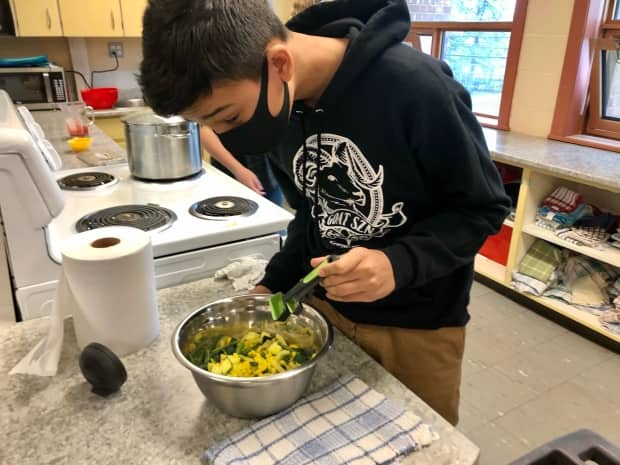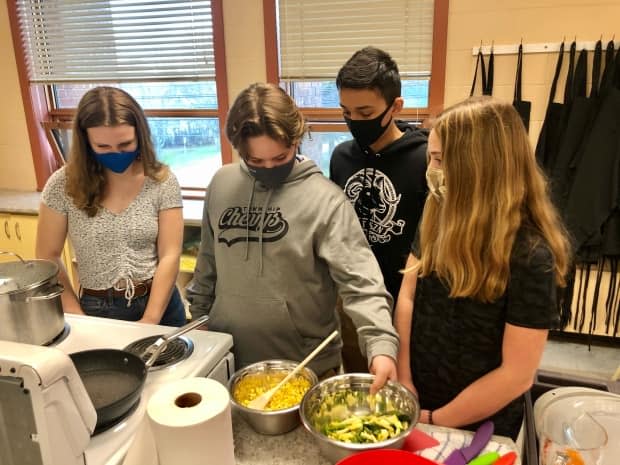Students learn Mi'kmaw traditions through cooking class

It's snack time at Summerside Intermediate School and Grade 8 student Youdin Ledwell-Cox is digging into a piping hot corn cake.
He made it himself in cooking class, with the help of Mi'kmaw elder John Doran.
The delicate Mi'kmaw treat has been steaming in a boiling pot of water for 40 minutes.
Wrapped in a corn husk, it looks like a small, neat envelope.

"This is a traditional corn cake that just has the corn and some water and it's baked in the corn husks," explains Doran.
Ledwell-Cox peels back the yellow husk, revealing the soft corn cake inside and carefully takes his first bite.
"It's definitely a good presentation. It looks and kind of tastes like a potato, it's good," he said.
Learning Indigenous history through the arts
This unique cooking class teaches students about traditional food eaten by the Mi'kmaq before colonization.
Led by Doran, a Sixties Scoop survivor and assistant professor of Indigenous education at UPEI, it's part of a new Arts Smarts program at the school, teaching the history of Canada's Indigenous peoples through the arts.
What better way to learn than by eating? — Mi'kmaw elder John Doran
In this case, it's the culinary arts.
"There are even Mi'kmaw people themselves who have forgotten that we had our own corn, our own maize, that we planted it," Doran said.
"When [Jacques] Cartier sailed through in 1534, he took great note of the miles and miles of Mi'kmaw corn that grew here on the Island. And it's a beautiful little corn."
Meaning behind each dish
Today's main course is succotash, made with fresh green and yellow beans and corn.
And to drink? A strawberry puree similar to a smoothie.
As Doran shares the recipes, he also talks about the meaning behind each dish.

"There are many stories about how sacred the strawberries are. The teaching is that they bring about peace. Their sweetness stops arguments," he said.
"Some people call them heart berries, because they're shaped like a heart . They're supposed to give you that love and forgiveness. They're a symbol of it."
Hands-on learning
Fourteen-year-old Kennah Brant stirs her succotash with a smile.
"It was meaningful to me because I'm Mohawk. We don't have a lot of recipes in my family, but it was good to see other cultures still holding onto theirs and other tribes still holding on to their culinary [traditions]," she said.
"I love my culture … so I really appreciated this."

Ledwell-Cox, who is part Cree, is also hoping to do his part to keep these traditional recipes alive.
"I definitely prefer lessons that are hands on. You're basically the lesson. You're doing it and you're understanding it as you go," he said.
"I definitely find it meaningful because my dad went to residential school. I just find it good that there are people in my class, they kind of learn about it. So they understand it further and just how it was a part of what Canada has been through."
Brant said learning about Mi'kmaw cultural traditions gives her a deep sense of pride.
"I've enjoyed it a lot. It's good that all my peers are learning about all this stuff. I'm always comfortable with who I am, and other people learning about all this is really helpful," she said.
"I've always kind of struggled with explaining it to people, but now that we're learning it at school and in an environment where everyone's learning, it's way easier."
'The way learning should look'
Vicki Allen-Cook, the arts education and creativity curriculum leader at the Department of Education, helps lead the Arts Smarts program and was delighted to watch students bustling around the kitchen.

"This is the way learning should look. Just listening to them today. They are so engaged, the learning that's happening," she said.
"You can feel the whole environment just being totally electrified by the way that they're learning at this moment. This is natural learning. It's so instinctive."
'What better way to learn than by eating?'
With the cooking finished, the meal is served.
Doran looks around the table to see students happily enjoying a feast of traditional food and his smile says it all.
"Oh, it's just fantastic. I hope they go home and show their families. It's so important that people know about this," he said.
"And what better way to learn than by eating?"
More P.E.I. news

